Red Blood Cell (RBC):- Part 2 – Normal Peripheral blood smear, and RBC Morphology
Peripheral blood smear
What sample is needed for Peripheral blood smear study?
- To assess RBC morphology, fresh smears and smears from the blood in EDTA must be made.
What are the Precautions for Peripheral blood smear study?
- A well-made smear is needed.
- A well-stained smear is also important.
- Otherwise, the analysis of cell morphology may be significantly distorted by poorly made and poorly stained smears.
What are the Indications for Peripheral blood smear?
- This is done to observe the morphology of RBCs, which includes variation and abnormality in size, shape, structure, Hb contents, and staining characteristics.
- Can diagnose the type of anemia.
- Can diagnose Thalassemia.
- Other abnormalities, such as hemoglobinopathies, can also be found.
- This also helps to see the effects of chemotherapy and radiation.
- Special stains can find infections, infestation, leukemia, and other diseases.
What are the variations in the morphology and shapes of RBCs?
- There are various sizes and shapes of RBC seen in the peripheral blood smear:
- Normocytic when the size is normal (7 to 8 µm).
- Normochromic when the color is normal.
- Microcytic when the size is smaller than normal RBC, and these are less than 6 µm.
- In iron deficiency anemia, thalassemia, and hemoglobinopathies.
- Macrocytic when the size is larger than > 8 µm.
- Found in liver diseases, alcoholism, and oval in megaloblastic anemia.
- Anisocytosis is an abnormal variation in size from the normal diameter of 6 to 8 µm, seen in severe anemia like iron deficiency, hemolytic anemia, and hypersplenism.
- Hypochromasia occurs when the RBCs are pale and have decreased Hb concentration.
- Poikilocytes are when RBCs have variations in shape.
- Spherocytes when RBCs are round without the central pale area.
- Elliptocytes when RBCs are oval or elongated.
- Found in hereditary elliptocytosis.
- Sickle cell is a crescent-shaped RBC seen in sickle cell anemia.
- The target cell is RBC, with a dark central area and clear space between this dark area and the periphery.
- Found in iron deficiency anemia, liver disease, post-splenectomy, and hemoglobinopathies.
- Schistocytes or helmet shape RBCs. These are irregularly contracted cells or fragmented RBCs.
- Burr cells are RBCs with spinous processes.
- Acanthocytes are RBCs with small cells with thorny projections.
-
- Found in liver disease, renal failure, and abetalipoproteinemia.
-
- Teardrop cells are RBCs with a tear-like appearance.
- The nucleated cell is RBC with the presence of a nucleus. These are normoblast or megaloblastic cells.
What are the inclusions in Red blood cells?
- Howell-Jolly bodies. These are spherical purple bodies within RBCs; these are nuclear debris.
- Heinz inclusion bodies are small, round inclusions of denatured hemoglobin seen with supravital stain or under phase microscopy.
- Siderocytes are the RBCs containing siderotic granules which stain blue with Prussian blue stain.
- Basophilic stippling is the presence of punctate stippling seen with the Wright stain.
What is the structure of Reticulocytes?
- Reticulocytes may also be seen in the peripheral blood smear.
- These are RBCs containing RNA and stained pinkish-blue in color. Methylene blue shows a reticular network.
How will you explain Rouleaux’s formation?
- This typical formation is the pilling of RBCs on each other or aggregated RBCs.
What are the Normal cells in the Peripheral blood?
- Band form neutrophils = 2% to 6%
- Neutrophils = 50% to 70%
- Eosinophils = 1% to 5%
- Basophils = 0% to 2%
- Lymphocytes = 20% to 44%
- Monocytes = 2% to 10%
How would you interpret peripheral blood smear?
- Screen the slide and note any abnormalities present in the smear regarding RBCs.
- It can evaluate the number or any abnormality of white cells.
- It can evaluate the number of platelets.
- So, the peripheral smear gives the following information:
- Any abnormality of RBCs.
- Any abnormality in white cells.
- Can assess the number of platelets.
What are the various presentations of anemias?
- In hemolysis, hemorrhage, or in increased erythropoiesis. There are basophilic or polychromatophilic macrocytes.
- Megaloblastic anemia shows oval macrocytes with increased lobules in the neutrophils.
- In hemoglobinopathy anemia, there are target cells, e.g., in thalassemia and Hb C.
- Target cells are also seen in iron- deficiency anemia and liver diseases.
- Thalassemia and lead poisoning show microcytes with stippling.
What are the Red blood cells’ morphology and their etiology?
- Note: please see more information on CBC and peripheral blood smear.
Questions and answers:
Question 1: What is the peripheral blood picture of thalassemia?
Question 2: What are the burr cells?












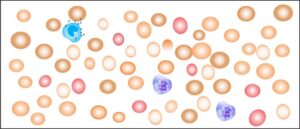





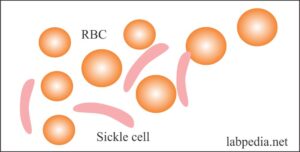
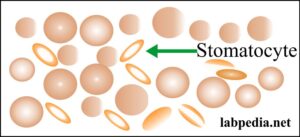


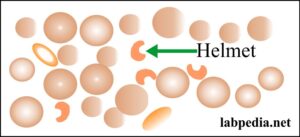
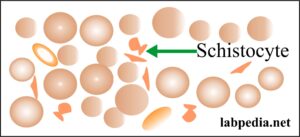
very informative. thank you
Good article. Shapes of some abnormal RBC type are missing that must be added.
Please, thanks for the comments. Can you specify missing abnormal cells?
very well
Thanks.